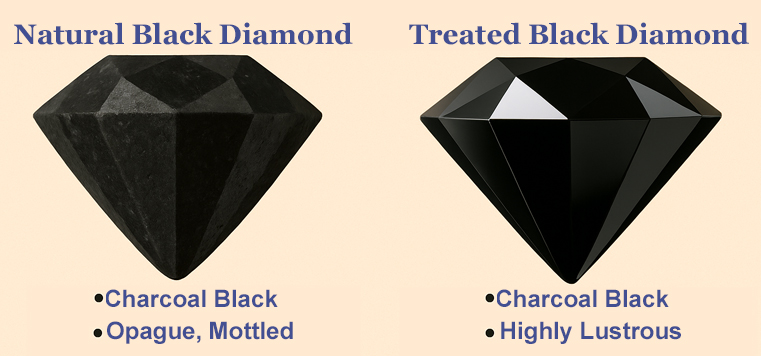What Are Black Diamonds?
Once considered undesirable, black diamonds have become a compelling choice in contemporary jewelry, admired for their dramatic beauty and distinct character. Their deep, opaque color offers a striking alternative to traditional white diamonds, making them a favorite in both men’s and women’s designs.
From modern engagement rings to bold statement pieces, black diamonds are celebrated by those who seek something unconventional yet refined. Their popularity has grown among designers and wearers alike, especially those drawn to a minimalist, edgy, or fashion-forward aesthetic.
APPEARANCE & CHARACTERISTICS
COLOR: Typically solid black or deep charcoal in tone. Unlike white diamonds, black diamonds do not exhibit brilliance or fire, but instead possess a distinctive metallic sheen.
CLARITY: Naturally opaque, with color resulting from dense internal inclusions that absorb light.
HARDNESS: While they retain a perfect 10 on the Mohs scale, black diamonds can be more brittle due to their internal structure, making them more susceptible to chipping if not handled with care.
CUT: Commonly fashioned in simple, elegant shapes—such as rose, cushion, or round—to emphasize their smooth, bold surface and dark allure, rather than sparkle.
CARAT WEIGHT & DENSITY:
Black diamonds are denser than white diamonds, meaning they appear slightly smaller in size for the same carat weight. A 1.00 ct black diamond may look visibly smaller than a 1.00 ct white diamond. This is important to consider when selecting for visual impact.
Natural vs. Treated: What’s the Difference?
TREATED BLACK DIAMONDS
Treated black diamonds begin as low-clarity white or gray diamonds and are subjected to heat or irradiation treatments to produce a smooth, solid black color. These diamonds are widely available due to their affordability and consistent appearance, making them especially popular in fashion jewelry and among budget-conscious buyers seeking a bold, modern look.
NATURAL BLACK DIAMONDS (Carbonado)
Natural black diamonds, often referred to as carbonado, are formed entirely by nature and owe their color to a high concentration of graphite and other mineral inclusions. These diamonds are typically found in Brazil and the Central African Republic and are known for their opaque, porous texture and irregular structure. Rarer and less uniform than their treated counterparts, natural black diamonds are prized for their uniqueness and raw, organic appeal.
| Feature | Natural Black Diamond | Treated Black Diamond |
|---|---|---|
| Origin | Naturally formed (carbonado) | Natural diamond altered by treatment |
| Locations | Brazil, Central African Republic | Mined globally, then treated |
| Appearance | Opaque, mottled, charcoal black | Jet black, smooth, and polished |
| Rarity | Rare | Common |
| Price Comparison | Typically 3 to 10 times more expensive than treated | Much more affordable and widely available |
| Resale Value | Higher (collector appeal) | Lower |
| Durability | More brittle due to internal structure | Often more stable after treatment |
| Used in | Designer, collector, custom fine jewelry | Fashion, trend jewelry, lower-cost collections |

Key Pages: Create & Customize Jewelry
Key Pages: Diamond Jewley From the Atelier
Essential Diamond & Jewelry Education
Important Links: Support & Policies
MyAntwerpDiamonds.com /
Some email responses from us may be filtered as spam or blocked altogether. To ensure you receive our emails, please provide your telephone or WhatsApp number for verification.



